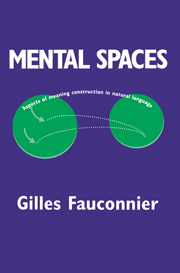Book contents
- Frontmatter
- Contents
- Foreword
- Preface
- Acknowledgments
- Introductory Note
- 1 Pragmatic Functions and Images
- 2 Roles and Multiple Connectors
- 3 Presuppositions: Floating, Transfer, and Projection Strategies
- 4 Counterfactuals and Comparatives
- Chapter 5 Transspatial Operators, Philosophical Issues, and Future Perspectives
- Notes
- References
- Index
3 - Presuppositions: Floating, Transfer, and Projection Strategies
Published online by Cambridge University Press: 20 January 2010
- Frontmatter
- Contents
- Foreword
- Preface
- Acknowledgments
- Introductory Note
- 1 Pragmatic Functions and Images
- 2 Roles and Multiple Connectors
- 3 Presuppositions: Floating, Transfer, and Projection Strategies
- 4 Counterfactuals and Comparatives
- Chapter 5 Transspatial Operators, Philosophical Issues, and Future Perspectives
- Notes
- References
- Index
Summary
Preliminaries
The vast literature on presuppositional phenomena periodically raises the following general questions: Is there a unified theoretical notion of presupposition? Can it be given a semantic or a pragmatic characterization? What grammatical constructions are associated with (or give rise to) presupposition? What is the effect of negation on presuppositions? How can one determine the presuppositions of complex sentences given the presuppositions of simple ones? Are “virtual” presuppositions cancellable by “stronger” implicatures and implications? What is the communicative purpose of presuppositions?
In the present chapter I will by no means deal with all these questions, but I will recast some of them and suggest somewhat straight-forward answers within a “mental space” framework. As in many linguistically oriented studies, the focus will be on the so-called projection problem, but I will suggest that the very formulation of this problem is essentially misconceived.
Before coming to grips with the actual phenomena, I will try to avoid possible misunderstandings by circumscribing explicitly the range of facts dealt with in the present context.
There is no agreement among presuppositionists about any precise definitional characterization of presupposition, and indeed such characterizations, when proposed, have so far proven inadequate (see the examples below). Surprisingly, however, there is a widespread consensus about which grammatical constructions are relevant in regard to the projection problem: namely, definite descriptions, factives, clefts, aspectuals, adverbial iteratives, and perhaps quantifiers such as only (in other words, essentially the list provided by Keenan (1971)).
- Type
- Chapter
- Information
- Mental SpacesAspects of Meaning Construction in Natural Language, pp. 82 - 108Publisher: Cambridge University PressPrint publication year: 1994



